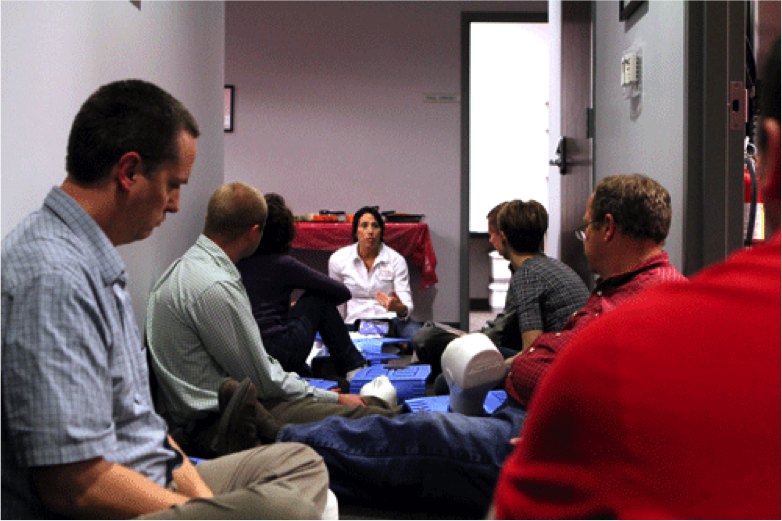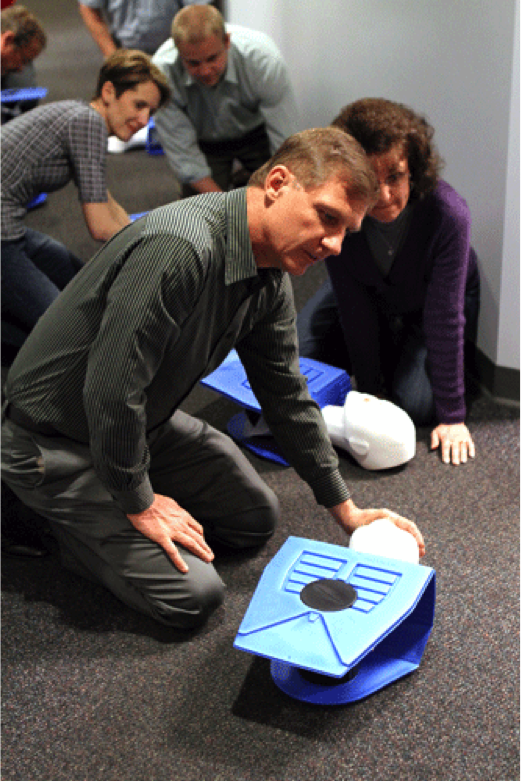
- Adult CPR (Cardiopulmonary Resuscitation)
- AED (Automated External Defibrillator) Training
- Basic first aid
- The Heimlich Maneuver
A representative from CPR Plus, which is affiliated with the National Safety Council, taught the session.

Jen Seitz, EPIC’s Finance Director attended the session.
“I have been here a year and we had to use the first aid kit for one injury,” Seitz said. “We haven’t had any situations with CPR or AED.”
So why did she make it a priority to attend?
“You never know when an emergency could happen,” Seitz said. “That is what is scary. It is one of those situations to be prepared for. Anytime you have a situation with injury, illness or first aid, panic is the first thing that happens. So if you have more knowledge, the more likely it will work out favorably. You panic when you don’t know.”
Seitz felt like she had just enough knowledge to make her dangerous.
“Big thing was, I used to lifeguard, but it has been forever. I wanted to update my certification and overall knowledge because so much has changed since I was last CPR certified.”
FACT: CPR certifications change every few years per American Heart Association guidelines.
“I was at the point where I almost felt impaired because I knew I would be doing it wrong according to the new guidelines. It is that feel that you are helpless to stand there and not help or help them incorrectly.”
The class allowed her to receive her AED Certification for defibrillator use as well as well as basic first aid training. “We did first aid which included; burns, lacerations, breaks, heat illnesses and recognizing the signs of heart attacks for men and women,” said Seitz.
Takeaway – What to do in case of a heart attack
Step 1: Remain calm: If your co-worker is having a heart attack remain calm and think back to your safety training.
Step 2: Look for the Signs: Signs of a heart attack in women can include: shortness of breath, indigestion lightheadedness, nausea or clammy. Women may also experience limpness in their left arm. The signs may not be obvious; rather signs tend to be exhaustion or other things that are easily dismissed.
With men it tends to be a sharper pain or stiffness in their chest or pressure on their chest. And men tend to have more pain down their left arm.
Step 3: Call 9-1-1: After assessing the situation call for emergency assistance.
Step 4: Take Action: The safety session taught employees to give an aspirin. These are located in safety kits in the kitchen, at the front desk and in two stations in the shop. Have the patient sit down. If you have the AED available go get it and follow the directions to strap it onto the patient.
“It is all voice command and voice prompted. It analyzes and assesses the person’s heart rate,” Seitz said. “So you can’t mistakenly use it. It takes the guess work out of it. If their heart rate became inconsistent it will prompt you on the correct usage.”
The AED will assess whether a shock treatment or CPR are required.
What to do in case of any other emergency? Remember the first rule, remain calm and do not panic. If you are unaware of how to handle a serious situation, do not hesitate to call 911 and contact a member of the safety team.
